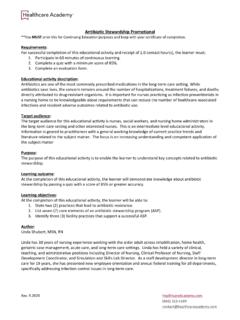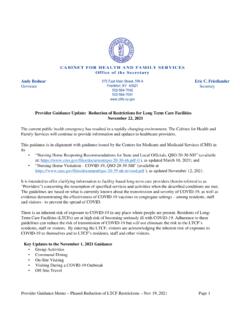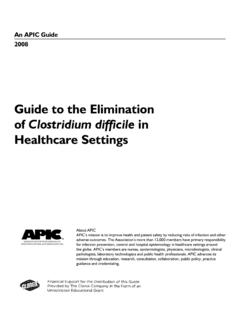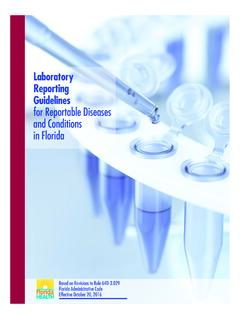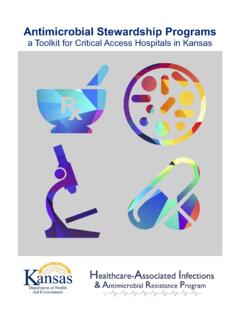Transcription of Hand Hygiene: Education, Monitoring and Feedback
1 Hand Hygiene: Education, Monitoring and Feedback1 PresenterLaraine Washer, MDAssociate ProfessorHospital EpidemiologistUniversity of Michigan Health SystemContributions byHeather M. Gilmartin, NP, PhD, CICD enver VA Medical CenterUniversity of ColoradoRuss Olmstead, MPH, CICT rinity Health, Livonia, MI2 Learning Objectives Calculate hand hygiene adherence rates based upon hand hygiene events and opportunities Compare and contrast different hand hygiene adherence Monitoring methods List components of a hand hygiene data collection tool3 Multi-Modal Approach toImprove Adherence Education Monitoring Feedback of data4 Education to Improve Adherence Educate personnel on the importance of improving hand hygiene adherence Train all healthcare personnel on hand hygiene at hire.
2 When job functions change and at least annually Personnel should: Display knowledge of the indications or moments to perform hand hygiene Demonstrate appropriate hand hygiene technique 5(EllingsonK,Infect Control HospEpidemiol, 2014)Hand Hygiene Adherence Monitoring Why is your healthcare facility measuring hand hygiene adherence? What is your hand hygiene adherence goal? What hand hygiene opportunities will you measure? How will measurements by performed? By whom? How will data be shared? Who is accountable for the data? 6 Why Measure Hand Hygiene Adherence?
3 Reasons for measuring hand hygiene adherence Reduce healthcare-associated infection rates Regulatory requirements Determine if performance requires improvement Compare performance to other organizations Inform improvement efforts 7 Hand Hygiene Adherence Monitoring Adherence = (Actions/Opportunities) x 100% Define opportunities you will audit Before room entry or patient contact Between clean and dirty tasks (difficult to audit) After patient contact or upon room exit8(Image from WHO Guidelines on Hand Hygiene in Health Care, WHO, 2009)
4 Hand Hygiene Adherence Monitoring 9 MethodProsConsDirect observation of handhygienetechnique Educational moment Does not measure adherence during patient careDirect observation of hand hygiene adherence Capturesinformation on product, technique Data summarized by personnel type, shift, unit Educational moment Timeand resource intensive Can influence performanceIndirect measurement of volume of alcohol-based hand rubor soap used Easyto track consistently Consumptionmay not correlate with appropriate use Biased by purchasing patternsSelf-report of hand hygiene adherence Capturesperceptions and barriers Unreliable Ratesoften inflatedPatientsatisfaction survey Optionin areas where direct observation difficult ( , ambulatory setting)
5 Unclear correlationDirect Measurement Methods of Observation for Hand Hygiene Covert observation, secret shoppers Training and standardized tools are necessary Inter-relator reliability Mobile handheld device for data collection Overt observation Coaching component Observation + intervention = measurevention Technology assisted Video Monitoring later reviewed by trained auditors Automated systems with wearable devices Eliminates selection and observer bias Can provide just-in -time reminders10 Specifics of Monitoring No accepted standard for number of observations Many hospitals use 30 or more observations per month
6 Per unit Can include data separated by role type Can include data by shifts May include documentation of contributing factors for failure11 Hand Hygiene Data Collection Tools12 CDC. ICAR Sharing Set targets for improvement Be realistic. Will be influenced by baseline data Align with rewards and recognition How often will hand hygiene adherence data be shared? How will it be displayed? Website, quality boards, emails etc. Who needs to see the data? Hospital leadership Unit leadership Individual healthcare personnel Patients13 Report Overall Unit Specific Data14 Report Before and After Adherence 15 Report Role Specific Data16 GOODTECHNIQUENOT-SO-GOODTECHNIQUE(Images from Mody L, JAMA Intern Med, 2015)Hand Hygiene Technique Using Hand Cultures17 Hand Hygiene TechniqueUsing Pathogen Simulation18(Images courtesy of Lona Mody, MD at the University of Michigan)
7 To Impact Change Everyone Needs to Know Their Role19(Image from the University of Michigan Health System Infection Prevention and Epidemiology)AccountabilityVanderbilt Center for Patient and Professional Advocacy 20(Image from Pyramid for Promoting Reliability and Professional Accountability, Vanderbilt Center for Patient and Professional Advocacy, 2016)References Boyce JM, PittetD. Healthcare Infection Control Practices Advisory Committee: HICPAC/SHEA/APIC/IDSA Hand Hygiene Task Force. Guideline for hand hygiene in health-care settings: Recommendations of the Healthcare Infection Control Practices Advisory Committee and the HICPAC/SHEA/APIC/IDSA hand hygiene task force.
8 Am J Infection Control 2002; 30(8):S1-S46. Consensus measurement in hand hygiene project. Joint Commission Center for Transforming Health Care. 2009. EllingsonK, Haas J, Aiello A, et al. Strategies to prevent healthcare-associated infections through hand hygiene. Infect Control HospEpidemiol. 2014; 35(8):937-60. Hand Hygiene: Why, How and When? World Health Organization. 2009, 1-7. Available at Mody L, KreinSL, Saint S, et al. A targeted infection prevention intervention in nursing home residents with indwelling devices: A randomized clinical trial.
9 JAMA Intern Med. 2015; 175(5):714-23. PittetD, AllegranziB, World Health Organization World Alliance for Patient Safety First Global Patient Safety Challenge Core Group of Experts. The World Health Organization Guidelines on Hand Hygiene in Health Care and their consensus recommendations. Infect Control ; 30(7):611-622. Pyramid for Promoting Reliability and Professional Accountability. Vanderbilt Center for Patient and Professional Advocacy. 2016. Available at WHO Guidelines on Hand Hygiene in Health Care. World Health Organization (WHO).
10 Published 2009. Available at YOU!22 Speaker Notes23 Speaker Notes: Slide 1 Welcome to part two of Hand Hygiene course titled Hand Hygiene: Education, Monitoring and Feedback . 24 Speaker Notes: Slide 2 The content for this module was developed by Laraine Washer, an infectious diseases physician and hospital epidemiologist at the University of Michigan Health System, with support from a multidisciplinary team of physicians, nurses and infection preventionistsdevoted to improving patient safety and infection prevention efforts. In particular, we would like to thank and acknowledge Dr.











